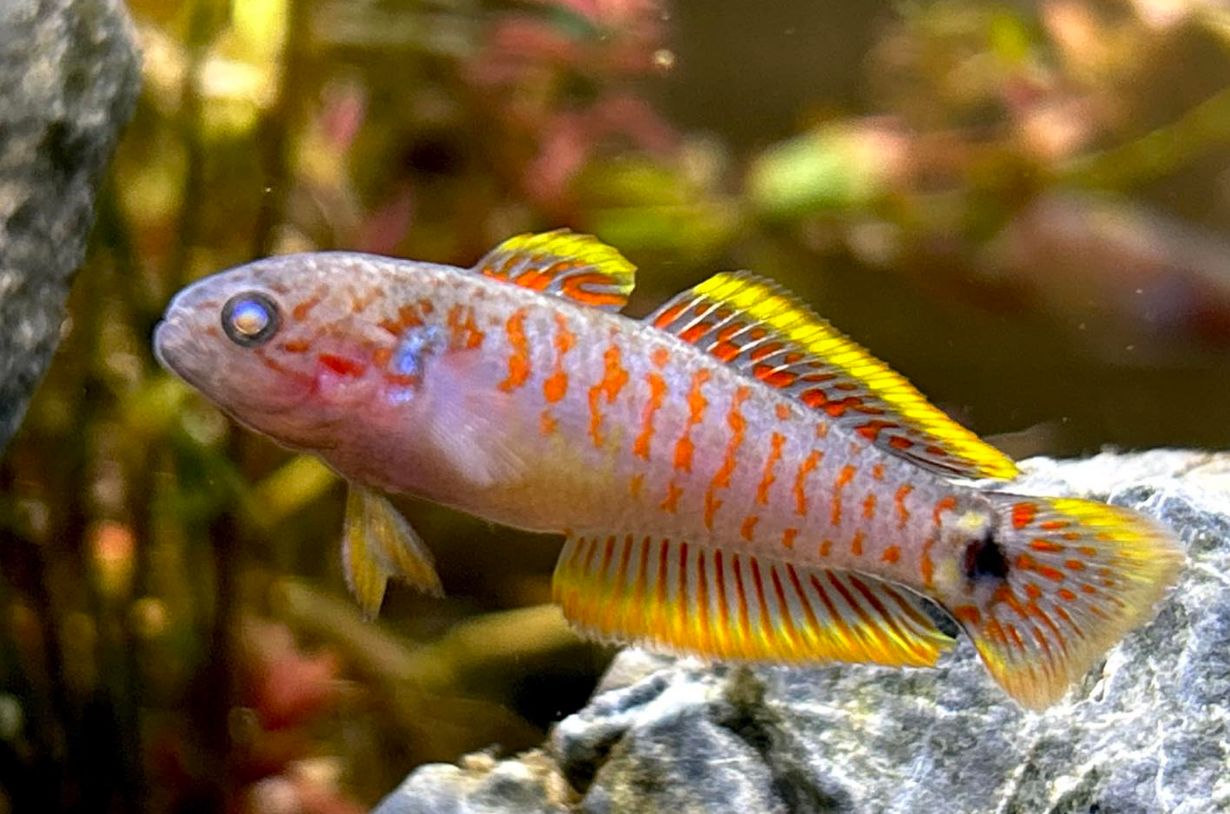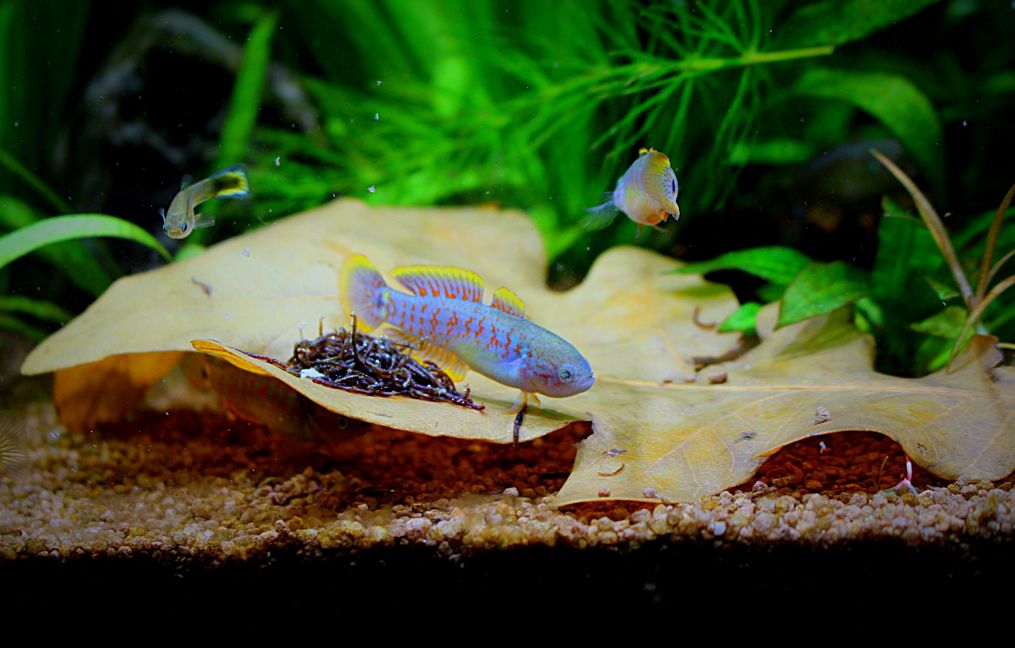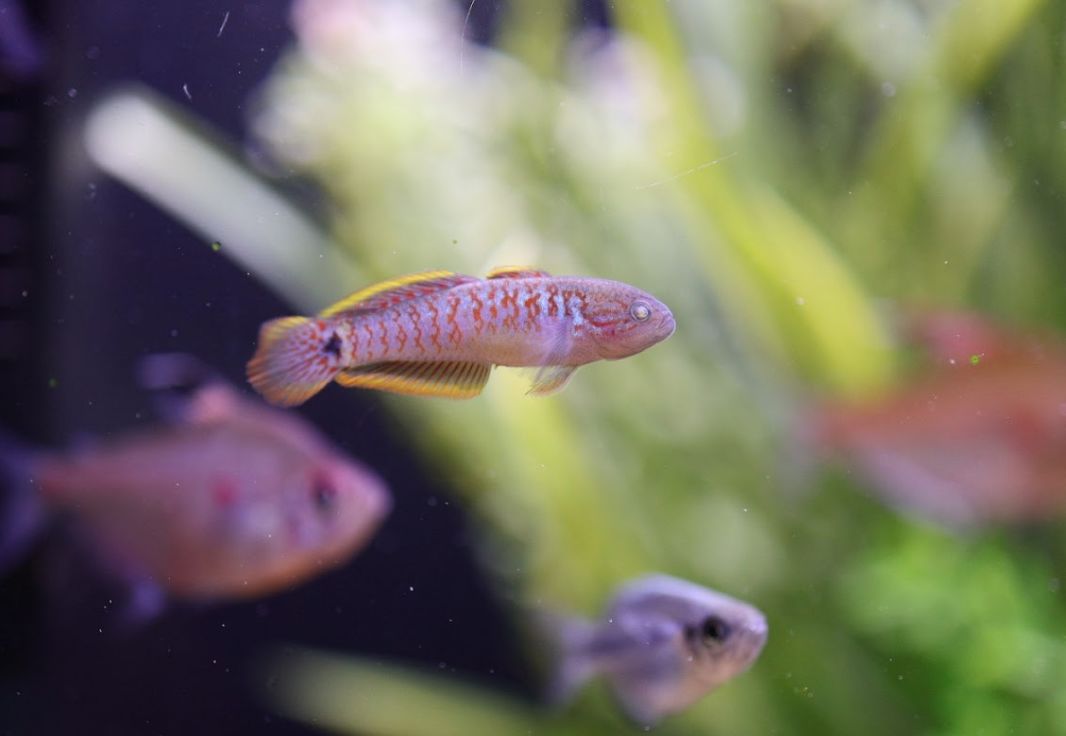The peacock gudgeon is a striking fish known for its vibrant coloring and peaceful temperament. As an unaggressive species, it makes an excellent choice for community tanks, promoting a harmonious environment. Despite these appealing traits, the peacock gudgeon remains relatively unknown among aquarists, likely due to a lack of accessible information.
In this text, we aim to bridge that knowledge gap by highlighting the benefits and care requirements of this captivating fish.

Contents
Habitat in the wild
The peacock gudgeon, known scientifically as Tateurndina ocellicauda, is a captivating member of the Eleotridae family, which comprises diverse small to medium-sized freshwater fish found in tropical and subtropical regions worldwide. These fish are celebrated for their vibrant colors and unique behaviors, making them a fascinating addition to any aquarium. Native to the freshwater streams and rivers of Papua New Guinea, the peacock gudgeon stands out as one of the smallest and most attractive representatives of its family.
In its natural habitat, the peacock gudgeon thrives in shallow, slow-moving waters of rivers, streams, and ponds, particularly in the southeastern part of Papua New Guinea. These fish prefer environments with plenty of vegetation and submerged plants, which provide essential hiding spots and shelter. They are commonly found in tropical forest ponds, swimming in calm waters where the pH ranges from 6.5 to 7.5, and temperatures remain between 22-28°C (72-82°F).
Description
Body
The peacock goby is a strikingly colorful freshwater fish belonging to the carp gudgeon family. Its body showcases a captivating blend of bluish and silvery hues, adorned with vibrant pink, yellow, and black markings along its body and fins.
This fish captivates observers with its vivid coloration. The back is a rich brown, complemented by shiny red dotted stripes that run along its azure sides, while the abdomen gleams bright yellow, especially pronounced in females during the spawning season. A distinctive blurred black spot marks the body where the tail begins. The dorsal, tail, and anal fins feature a light blue shade embellished with red spots, adding to the peacock goby’s overall allure.
Size
In the wild, male peacock gudgeons can reach lengths of up to 7.5 cm (3 inches), while females typically grow to about 5 cm (2 inches). However, in captivity, these fish tend to be smaller. Males are generally slightly larger and more vibrant, showcasing the sexual dimorphism that makes them particularly appealing.
As with many fish species, the size of individual peacock gudgeons can vary based on genetics, diet, and environmental conditions. With proper care and nutrition in an aquarium setting, these fish can achieve their potential size within a year or two.
Lifespan
In captivity, peacock gudgeons typically have an average lifespan of 3 to 5 years. Like many fish species, their longevity can be significantly influenced by factors such as water quality, diet, genetics, and the overall care provided by their keeper.
| Characteristic | Description |
|---|---|
| Scientific Name | Tateurndina ocellicauda |
| Common Names | Peacock Gudgeon, Peacock Goby |
| Family | Eleotridae |
| Native Region | Papua New Guinea |
| Size | 3-4 inches (7-10 centimeters) |
| Lifespan | 3-5 years (in captivity) |
| Temperament | Peaceful and non-aggressive |
| Sexual Dimorphism | Males are more colorful with vibrant blue, green, yellow, and orange colors; females are less colorful and have a rounder abdomen. |
| Preferred pH | 6.5 to 7.5 |
| Water Temperature | 22-28°C (72-82°F) |
| Habitat | Slow-moving freshwater streams and rivers with sandy or gravelly substrates and plenty of vegetation. |
| Diet | Carnivorous; prefers live and frozen foods like brine shrimp, bloodworms, and small insects. Also accepts high-quality pellets and flakes. |
| Behavior | Relatively peaceful but may exhibit territorial behavior during breeding. Males may display courtship rituals to attract females. |
| Tank Requirements | Provide a well-maintained aquarium with hiding spots, live plants, and a sandy or fine gravel substrate. Water quality should be regularly maintained. |
| Compatibility | Can be kept with other peaceful fish in a community aquarium. Avoid aggressive or large species that may intimidate or outcompete them. |
| Breeding | Males build bubble nests and display courtship behaviors. After spawning, eggs are guarded by the males until hatching. |
| Conservation Status | Not listed as endangered; relatively common in the aquarium trade. |
Difficulties in keeping
The peacock goby is a small, calm, and non-aggressive fish, making it an ideal choice for enthusiasts who appreciate vibrant and petite species. However, there are some considerations to keep in mind. One notable drawback is that peacock gobies often prefer live food, which may limit dietary options. Additionally, they can be susceptible to infectious diseases, a common cause of mortality in aquarium settings.
Fish imported from Southeast Asia are particularly vulnerable, as their immune systems may be weakened due to extended transportation. In contrast, those bred in captivity typically enjoy better health and can live up to 4 to 5 years when provided with proper care.

Care and keeping in a tank
Tank size
For a single pair of peacock gudgeons, a minimum tank size of around 10 to 15 gallons (38 to 57 liters) is recommended. If you plan to keep multiple peacock gudgeons or other compatible fish, increasing the tank size to accommodate their needs is essential.
Although peacock gudgeons are relatively small, they thrive in an environment that offers ample space to swim and explore. A larger tank promotes stable water parameters and reduces potential aggression among tank mates, particularly during breeding.
For a small community tank that includes peacock gudgeons and compatible species—such as larger tetras or peaceful gouramis—a size of around 20 to 30 gallons (75 to 114 liters) or more is advisable, depending on the number of fish you intend to keep.
Creating a comfortable habitat with plenty of hiding spots, plants, and aquarium decor will enhance the well-being of your peacock gudgeons.
Water parameters
Temperature: Keep the water temperature between 22-28°C (72-82°F), reflecting their preferred tropical environment.
pH: Aim for a pH level of 6.5 to 7.5, maintaining slightly acidic to neutral conditions. Stability is key, so avoid extreme fluctuations.
Hardness: Target a general hardness (GH) level of around 5 to 12 dGH, ensuring the water is soft to moderately hard.
Ammonia, Nitrite, and Nitrate: Ammonia and nitrite levels should remain at zero, as these compounds are harmful to fish. Regularly test your water to ensure these are absent. Nitrate levels should be monitored, ideally kept below 20-30 ppm.
Filtration and Water Quality: Invest in a quality filtration system to maintain clear and clean water. Perform regular water changes of 20-25% every one to two weeks to remove accumulated nitrates and pollutants. While peacock gudgeons appreciate clean water, avoid strong currents, as they may feel uncomfortable in a tank with excessive water flow.
Oxygenation: Ensure adequate oxygenation, especially if you have live plants or multiple fish. Proper aeration not only maintains good water quality but also contributes to the health of your peacock gudgeons.
Substrate
Using a dark tank bottom substrate will enhance the beauty of peacock gudgeons, allowing their vivid colors to shine. A sandy or fine gravel substrate is ideal for several reasons:
Natural Habitat: This substrate type closely resembles the natural environment of peacock gudgeons, helping to replicate the conditions they would encounter in the wild.
Digging and Foraging: Peacock gudgeons naturally sift through the substrate in search of food, such as small insects and invertebrates. A sandy or fine gravel substrate encourages this instinctive behavior.
Nest Building: During breeding, male peacock gudgeons create bubble nests on the substrate to protect their eggs. A suitable substrate supports this nesting behavior, contributing to successful breeding.
Planting: If you plan to incorporate live plants in the aquarium, sandy or fine gravel substrates allow for easy planting and healthy root growth.
Decor
Males of the species exhibit mild territorial behavior, so it’s essential to provide a variety of shelters in their environment. While they may adopt intimidating poses or even make sudden strikes at rivals, these actions are typically meant to scare rather than injure. To ensure their comfort, peacock gudgeons thrive in tanks equipped with caves and crevices where they can retreat and feel secure. Utilizing decorations such as ceramic caves or PVC pipes can effectively create these hiding spots.
In tanks devoid of decorations and plants, peacock gudgeons tend to cluster around any small shelter available, limiting their swimming activity. Incorporating driftwood and rocks into the aquarium not only offers essential hiding places but also promotes algae growth, which can serve as an additional food source.
Adding live aquatic plants enhances the tank’s visual appeal and provides more hiding spots, contributing to improved water quality. Suitable options include Java fern, Anubias, Amazon sword, and Vallisneria. Moreover, peacock gudgeons feel particularly safe in environments rich with floating plants. Incorporating floating options like water lettuce or duckweed can help diffuse light and provide shade, reducing stress while offering additional cover.
Lighting
Tank lighting should be kept dim, as peacock gudgeons prefer softer light conditions. Choose appropriate aquarium lighting that highlights the vibrant colors of the fish while complementing the beauty of the decor.

Diet
Understanding the dietary needs of peacock gudgeons is essential for their health and well-being, especially considering their specific food preferences. One primary drawback of keeping peacock gudgeons is their strong inclination toward live food. While some individuals can be trained to accept small pellets, many tend to ignore dry food altogether.
When it comes to frozen options, peacock gudgeons are generally reluctant to consume items like cyclops, copepods, or bloodworms. Feeding them frozen brine shrimp is also not advisable, as they prefer to gulp their food rather than chew it. Instead, offering live foods such as daphnia, small shrimp, or even finely chopped earthworms can entice them and provide the nutrition they need.
To ensure that peacock gudgeons receive a balanced diet, consider incorporating a variety of live foods alongside any dry options they may accept. This approach not only meets their dietary preferences but also encourages their natural hunting instincts, contributing to their overall health and activity level in the aquarium.

Tank mates
Peacock gudgeons are calm and peaceful fish, making them excellent residents of a community tank. They coexist harmoniously with tank mates, even those smaller than themselves. However, it’s important to avoid pairing them with small shrimp, such as cherry shrimp, as they may become prey. Instead, opt for larger shrimp like Amano shrimp.
When feeding, peacock gudgeons tend to be slow and deliberate, so ensure they receive enough food, especially in tanks with faster, more active fish.
When selecting tank mates, consider the peacock gudgeon’s peaceful nature and small size to prevent bullying or stress.
Gender differences: male vs female
Male and female peacock gudgeons display distinct differences, particularly in appearance and behavior, which can help in identifying each sex.
The most noticeable difference is coloration. Males exhibit vibrant and striking hues of blue, green, yellow, and orange, earning them the name “peacock.” In contrast, females tend to have more subdued tones, making them less visually prominent.
Body shape also varies between the sexes. Males typically have a slimmer and more elongated body, while females may appear rounder, especially when carrying eggs. This slight difference can be helpful when observing them.
Fins are another distinguishing feature. Male peacock gudgeons often have more elaborate and elongated dorsal and anal fins, edged with bright colors. These fin structures are more pronounced in males than in females.
Size can vary slightly, with males sometimes growing a bit larger, but this difference is generally minimal and not a reliable indicator of sex.
Behavior during breeding and courtship is an important aspect to consider. Males actively engage in courtship rituals to attract females, establishing territories and performing fin displays and dances. In contrast, females tend to explore potential nesting sites with interest.
When a female is ready to lay eggs, her abdomen may appear noticeably rounder due to the presence of eggs. Males play a vital role in guarding the eggs, often fanning them with their fins to ensure a steady oxygen flow.
In summary, male peacock gudgeons are more colorful and exhibit specific behaviors during courtship, while females are typically rounder and less vibrant, especially when carrying eggs. Understanding these differences can enhance your experience in keeping these captivating fish.
Breeding
The peacock gudgeon breeds in pairs, making it essential to place the couple in a separate spawning tank equipped with shelters. This setup allows the female to lay her eggs in a safe environment. A female ready to spawn will have a rounded, large, and high yellow-colored abdomen, making her easy to identify.
To encourage breeding, you can raise the water temperature in the spawning tank by 1 to 2 °C compared to the community tank. During the mating display, the abdominal fins of both fish change color; the male’s fins turn dark brown, while the female’s fins become black.
The female peacock gudgeon typically lays between 50 to 200 eggs, each about 1 mm in diameter. After spawning, it’s crucial to remove the female from the tank to prevent her from eating the eggs.
The male takes on the role of a caring parent, remaining in the cave with the eggs and neglecting to eat during this period. He actively fans the eggs with his fins, ensuring they receive sufficient oxygen. In about 6 to 10 days, depending on the water temperature, transparent larvae measuring 2 to 3 mm will hatch.
Once the larvae appear, the male should also be removed from the tank. Within 2 to 4 days, the juveniles begin to swim freely. At this stage, you can start feeding them infusoria, brine shrimp nauplii, or rotifers.
With proper care, peacock gudgeon juveniles can grow approximately 1 cm each month. Within a month, you will notice a black spot near their tail fin, although they will achieve the full coloration of adult fish in about 4 months. They typically reach reproductive maturity at 6 to 8 months of age.